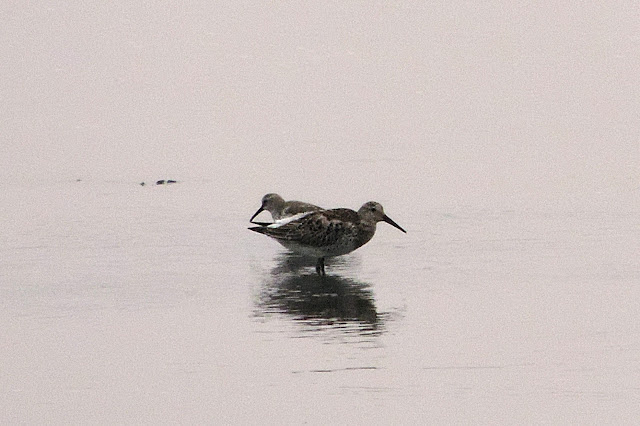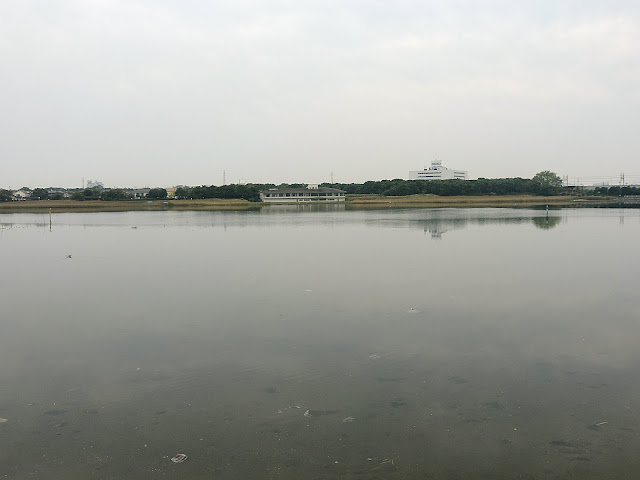Finally, wintering ducks have arrived in the Ecology Park. A pair of Mallards (Magamoマガモ) were recorded on the 11/Oct for the first time this season.
11/Oct/2015
The number of the Mallards had grown up to 4 (2males, 2females) on 18/Oct, but there was still no sign of Teals, which normally arrive earlier than any other duck.
The male Mallard had a shabby look! It would still take a bit of time to get a lovely green head back:)
The ducks were picking up acorns from the bottom of the pond, which must be a valuable energy source after a long journey and for the winter.
Spot-billed Ducks (Karugamoカルガモ) were doing the same thing as well.
18/Oct/2015
Sunday 18 October 2015
Monday 12 October 2015
A Beautiful Autumnal Morning
A pair of Varied Tits (Yamagaraヤマガラ) were busy flying back and forth and I was wondering what exactly they were doing.
A-ha! I realised that they were caching food for a rainy day.
How can you remember where you have buried them?!
The seeds they were collecting were of Japanese Snowbell (Egonokiエゴノキ), famous as the Varied Tits' favourite, which are said to be extremely bitter to human taste.
Japanese White-eyes (Mejiroメジロ) were taking advantage of autumn-blooming cherry blossoms.
Japanese Pygmy Woodpeckers (Kogeraコゲラ)
A small flock of Oriental Greenfinches (Kawarahiwaカワラヒワ)
A large number of Dragonflies were sitting quietly in the sun everywhere to be warmed up in the park. The time left for them is rather short and they must make the most of it.
Saturday 3 October 2015
Yatsuhigata II
Some wintering ducks arrived in Yatsuhigata and I saw Pintails and Teals on that day.
Teals (Kogamoコガモ) were busy dabbling on the surface of the mud.
The light wasn't great for taking photos but they came quite close to the embankment.
Males are now in eclipse plumage so it was quite hard to identify them as a male or female.
(especially when their bills were coated in mud!!)
A flock of Pintails (Onagagamoオナガガモ) was in the middle of the pool.
There were not so many waders as I'd thought there'd be. Autumn migration is towards the end.
A lone Ringed Plover (Hajirokochidoriハジロコチドリ) was foraging at low tide.
Ringed Plovers are spotted in Chiba far more infrequently than Little Ringed Plovers so I must say I was very lucky*)
A Great Knot (Obashigiオバシギ) was foraging with other waders.
Grey Plovers (Daizenダイゼン) and Dunlins (Hamashigiハマシギ) are the two main waders which stay and winter here in Yatsuhigata.
a Grey Plover
a bit artistic??
The water was gradually coming in through the very narrow waterways and suddenly all the cormorants, herons and egrets flew to one spot like it was a competition.
Fish, which were coming in with the tide, were stuck in shallow water and they had no chance against big eaters like those hungry birds!
By the time I got back to the north end of the mudflats, the water covered the whole area which was mudflats just half an hour ago.
A peregrine falcon flew in the sky and all went quiet.
a White Wagtail (Hakusekireiハクセキレイ)
Teals (Kogamoコガモ) were busy dabbling on the surface of the mud.
The light wasn't great for taking photos but they came quite close to the embankment.
Males are now in eclipse plumage so it was quite hard to identify them as a male or female.
(especially when their bills were coated in mud!!)
A flock of Pintails (Onagagamoオナガガモ) was in the middle of the pool.
There were not so many waders as I'd thought there'd be. Autumn migration is towards the end.
A lone Ringed Plover (Hajirokochidoriハジロコチドリ) was foraging at low tide.
Ringed Plovers are spotted in Chiba far more infrequently than Little Ringed Plovers so I must say I was very lucky*)
A Great Knot (Obashigiオバシギ) was foraging with other waders.
Grey Plovers (Daizenダイゼン) and Dunlins (Hamashigiハマシギ) are the two main waders which stay and winter here in Yatsuhigata.
a Grey Plover
a bit artistic??
The water was gradually coming in through the very narrow waterways and suddenly all the cormorants, herons and egrets flew to one spot like it was a competition.
Fish, which were coming in with the tide, were stuck in shallow water and they had no chance against big eaters like those hungry birds!
By the time I got back to the north end of the mudflats, the water covered the whole area which was mudflats just half an hour ago.
A peregrine falcon flew in the sky and all went quiet.
a White Wagtail (Hakusekireiハクセキレイ)
Yatsuhigata I
The sky was very dull and grey, which wasn't a great day for birding but, anyway, there I was.
It was at low tide and many, many egrets and herons looked happy!
So did cormorants:)
a Great Egret (Daisagiダイサギ)
a Grey Heron (Aosagiアオサギ)
Black-winged Stilts (Seitakashigiセイタカシギ)
long legs!
A Black-tailed Gull (Uminekoウミネコ) flew towards me and landed only a few yards away from me.
Not to say hello to me but to find something on the pebble.
How on earth did you spot it from miles away?
He took the crab and dipped it in the water.
salty flavouring?
At the lowerst tide, the mudflats look totally different and rather deserted.
Huge numbers of Cormorants (Kawauカワウ) were chilling out with a couple of Grey Herons and Black-tailed Gulls:)
I went to the observatory to check the sighting board and to wait for the tide to come in.
He was the one who pleased me while I was having a cup of coffee:)
It was at low tide and many, many egrets and herons looked happy!
So did cormorants:)
a Great Egret (Daisagiダイサギ)
a Grey Heron (Aosagiアオサギ)
Black-winged Stilts (Seitakashigiセイタカシギ)
long legs!
A Black-tailed Gull (Uminekoウミネコ) flew towards me and landed only a few yards away from me.
Not to say hello to me but to find something on the pebble.
How on earth did you spot it from miles away?
He took the crab and dipped it in the water.
salty flavouring?
At the lowerst tide, the mudflats look totally different and rather deserted.
Huge numbers of Cormorants (Kawauカワウ) were chilling out with a couple of Grey Herons and Black-tailed Gulls:)
I went to the observatory to check the sighting board and to wait for the tide to come in.
He was the one who pleased me while I was having a cup of coffee:)
Subscribe to:
Posts (Atom)
























































